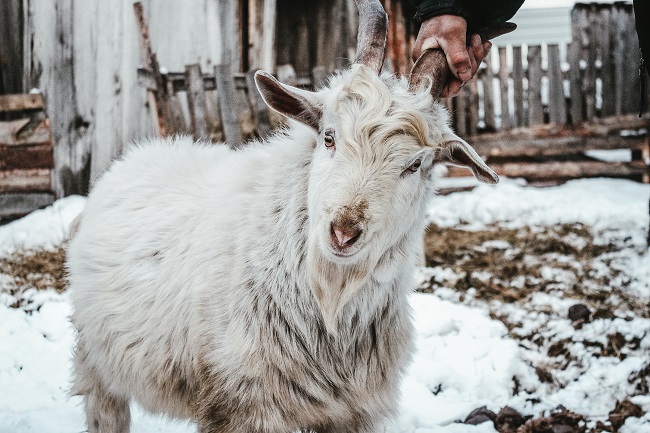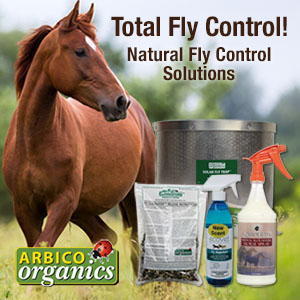
Goats are rather hardy animals; however, they are susceptible to pneumonia, a possible result of being subjected to damp, drafty conditions. Dairy goats can handle the cold temperatures if they have a shelter to get out of the wind and have a good undercoat of hair to protect them from frigid temperatures. The ideal shelter for dairy goats should have a door or enclosure to block wind and precipitation from blowing in on the animals. Goats thrive much better in the cold if they can avoid being wet. Listed below are ten tips that will help keep your goats healthy during cold weather.
#1 Heating lamps may be used for younger animals, but most healthy, adult goats are better off self-regulating their own body temperatures and if need be, cozying up with their herd mates for added warmth.
#2 Goats prefer to sleep and/or relax up off the ground. Wooden pallets are great for this purpose because they allow the goat to get off the ground, and bedding can be placed on top of the slats for added insulation. Pallets are also easily moved for cleaning purposes.
#3 Bedding should be fluffed and rotated as needed. It is important to make sure the bedding is dry and selection of bedding material that will drain well and “fluff up” is a plus.
#4 Most healthy dairy goats will grow a nice thick coat of hair in the fall. When cold weather is around the corner, a white fuzzy layer of hair (called the undercoat) is noticeable. This undercoat is what keeps the goat warm. Some types and/or bloodlines of dairy goats do not develop this undercoat. These goats are candidates for a nice, well-fitted goat coat. Goat coats can be made from fleece or other warm material that fastens around the goat. Many caprine supply companies sell goat coats. Dog coats made for very large breeds will also work nicely.
#5 Goats can keep warm and maintain body temperature if they are able to cuddle up together and are out of the wind. However, sometimes kids that are born in the winter need special care so that they do not freeze. Kids have a harder time maintaining their own body temperature. Knitted dog sweaters are great for kids. The sweater covers the back to the tail as well as chest.
#6 Even if the weather is cold, and even with snow on the ground, goats will need to have ample time to run and jump around. Exercise helps keep energy levels high, lungs clear, and appetites hearty. If there isn’t a lot of wind or heavy precipitation, dairy goats are better off being outside playing during the day. Goats prefer being able to move around and stretch their legs. Keep in mind that the snow and ice can get wedged between their hooves, so take care to make sure their feet are properly trimmed, and the ice is removed as often as possible.
#7 During the coldest months, it may be necessary to feed a supplemental grain ration. Eating is one important way that animals maintain body temperature. Keeping good clean hay in front of dairy goats at all time will keep their rumens active and energy level high. If they appear to lose weight during the colder months, increase the feed ration accordingly.
#8 Round hay bales are great for paddocks or barnyards. Goats can feed continually off the round bales, and several goats can eat off one bale for a month at a time. It is important to make sure the bale is fenced off with wire panels or is placed in such a way that the goats cannot climb on the bale and ruin the feed matter with urine or feces.
#9 Free choice minerals and salt/mineral blocks should be always available for consumption. Generally, goats will only eat the minerals when their body needs them.
#10 Water is extremely important for animals to consume. Without it, animals can dehydrate, and become sick. In the cold, livestock have a tendency not to drink as much because of the temperature. Consider investing in electric tank or bucket warmers which will maintain water at an above-freezing temperature.
Did You Know
The Pygmy goat originated in Africa and was imported to the United States in the 1950s. As its name implies, it’s smaller than dairy goats, but it produces a respectable amount of milk for its weight and food consumption. Most people raise them for show and fun instead of meat or milk.
The Nigerian Dwarf goat is a miniature dairy goat of West African origin. Nigerian Dwarves have three different color lines — black and white, brown, which can be broken with white, and the third is gold, which can also be broken with white. Bucks are to be no more than 23” at the withers and does no more than 21”.
Related Articles & Free Email Newsletter Sign Up
How Milk Secretion Differs in Goats and Cattle
Proper Goat Herd Health Procedures for Breeding




Comment here